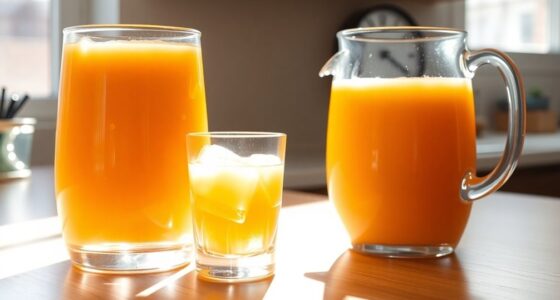The average juice yield from one medium lime is about 2 tablespoons, or 1 ounce. However, this can vary based on the lime's size and ripeness. To get the most juice, try rolling the lime on the countertop before cutting it. Fresh lime juice is always best for flavor, especially in dishes like ceviche or cocktails. Want to know how many limes you need for specific recipes? There's more to explore on this topic!
Key Takeaways
- A medium lime typically yields about 2 tablespoons (1 ounce) of juice.
- After rolling and cutting, expect approximately 1/2 ounce of juice from each half of the lime.
- The size and ripeness of the lime can affect the total juice yield.
- For recipes requiring 1/4 cup of lime juice, about 2 limes are needed.
- Fresh lime juice is preferred over bottled for its superior flavor and authenticity.

Have you ever wondered how much juice you can squeeze from a lime? If you're planning a recipe that calls for lime juice, knowing the juice yield from one lime can be quite helpful. On average, you can expect about 2 tablespoons of fresh lime juice from a medium lime, which is roughly equivalent to 1 ounce. That's enough to add a vibrant flavor to many dishes, but it's essential to maximize that juice extraction to get the most out of your limes.
When you cut the lime, you want to ensure you're getting every drop. A simple technique involves rolling the lime on your countertop before you slice it. This action helps break down the membranes inside the fruit, making it easier to extract juice. After rolling, cut the lime in half and squeeze it out. You'll likely get around 1/2 ounce of juice from each half, so if you're using one lime, that's about 1 ounce total. This is perfect for recipes that require a hint of lime without needing to use multiple fruits.
For recipes that require a bit more lime juice, like a refreshing ceviche or a zesty vinaigrette, you might need more than just one lime. If a recipe calls for 1/4 cup of lime juice, you'll typically need about 2 limes to meet that requirement. This gives you approximately 4 tablespoons of juice, ensuring your dish has that fresh lime flavor you're after.
It's also worth noting that the juice yield can vary slightly based on the lime's size and ripeness, so always keep that in mind when you're squeezing.
Fresh lime juice is favored in cooking for its vibrant flavor, and it truly makes a difference in your culinary creations. Whether you're mixing a cocktail or whipping up a marinade, the tangy zest of fresh lime juice elevates the taste.
Using bottled lime juice might seem convenient, but it often lacks the brightness and authenticity that only fresh lime can provide.
Frequently Asked Questions
How Much Juice Is in 1 Lime?
When you’re juicing a lime, you can usually expect to get about 2 tablespoons of juice from one medium lime. That’s roughly 1 ounce, which is handy for recipes. If you’re planning to make a large batch of margaritas or a zesty salad dressing, you might be wondering how many limes for juice you’ll need to buy. For instance, if your recipe calls for 8 ounces of lime juice, you’ll need approximately 8 medium limes. Always remember to roll the limes on the counter before cutting them; this helps maximize the juice extraction from each fruit.
If you need more juice, remember that two limes can yield about 1/4 cup, while four will give you around 1/2 cup.
To get the most juice, pick firm, smooth-skinned limes and roll them before cutting. You'll maximize your extraction!
Can I Substitute Bottled Lime Juice for Fresh Lime Juice?
Yes, you can substitute bottled lime juice for fresh lime juice, but keep in mind that the flavors differ.
Fresh lime juice usually has a brighter taste, while bottled juice can be flat and may contain added sugars.
When substituting, start with a one-to-one ratio, but be ready to adjust based on your taste.
For recipes that rely heavily on lime flavor, fresh juice is often the better choice for achieving the best results.
How Much Juice Is in One Key Lime?
When you're working with key limes, you'll find that one typically yields about 1 tablespoon of juice.
Because they're smaller than regular limes, you might need several to get enough juice for your recipes.
Their unique acidity and floral flavor make them perfect for dishes like Key lime pie.
If you want the best taste, stick with fresh juice instead of bottled options, as the flavor difference is noticeable.
How Much Real Lime Equals 1 Lime?
When you're trying to figure out how much real lime equals one lime, it's essential to consider the size and type of lime.
Generally, one medium lime gives you about 2 tablespoons of juice. If you're using key limes, you might need a few more to match that amount since they're smaller.
Just remember, the juice yield varies slightly, but planning for about 2 tablespoons per lime is a good rule of thumb.
Conclusion
In the culinary world, a lime's juice is like a burst of sunshine on a cloudy day; it brightens up your dish. You can expect to squeeze about 2 tablespoons of juice from one lime, enough to elevate your favorite recipes. Whether you're making a zesty marinade or a refreshing drink, that little lime packs a punch! So next time you reach for one, remember it's more than just a fruit—it's a flavor enhancer waiting to shine.
Cindy thoroughly researches juicing trends, techniques, and recipes to provide readers with practical advice and inspiration. Her writing style is accessible, engaging, and designed to make complex concepts easy to understand. Cindy’s dedication to promoting the advantages of juicing shines through her work, empowering readers to make positive changes in their lives through the simple act of juicing.











